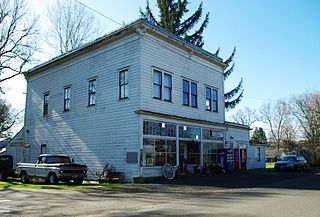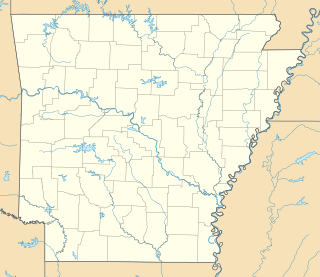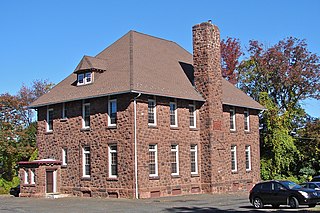
Orenco is a former company town in Washington County, Oregon, United States, located between Hillsboro and Aloha. The former community of Orenco now forms the Orenco neighborhood in Hillsboro, which is the site of the Orenco Station housing development.

The Claymont Stone School, also known as Naaman's Creek School #1, is a historic schoolhouse built in 1805, on land donated by Founding Father John Dickinson, in Claymont, Delaware, on the Philadelphia Pike just south of the Darley House. The school was listed in the National Register of Historic Places in 1990. Its official Delaware State Historic Marker indicates that the school "may have been the first racially integrated public school in the State."

Sunnyside Gardens is a community within Sunnyside, a neighborhood in the New York City borough of Queens. The area was the first development in the United States patterned after the ideas of the garden city movement initiated in England in the first decades of the twentieth century by Ebenezer Howard and Raymond Unwin, specifically Hampstead Garden Suburb and Letchworth Garden City.

Worth's Block, also known as the Gator Club, is a historic building in Sarasota, Florida. It is located at 1490 Main Street. It was added to the U.S. National Register of Historic Places in 1998.

Fair Park College Preparatory High School, also known as Fair Park College Prep. Academy, and Fair Park Medical Careers Magnet High School is a former high school located at 3222 Greenwood Road in Shreveport, Louisiana, U.S. When it opened as Fair Park High School in 1928, it was the second high school in the city. C.E. Byrd High School had opened three years earlier in 1925. The institution is now known as Fair Park Middle School.

The Dunbar Hospital was the first hospital for the black community in Detroit, Michigan. It is located at 580 Frederick Street, and is currently the administrative headquarters of the Detroit Medical Society. It was listed on the National Register of Historic Places in 1979.

Larue is an unincorporated community in Benton County, Arkansas, United States. Larue was established in the late 19th century as a community for orchard workers. In the 1920s, the community transitioned to an economy based on animal husbandry and grain farming as orchard production declined in the area.

St. John the Baptist Catholic Church is a historic Roman Catholic church in Marion Township, Mercer County, Ohio, United States. Located in the unincorporated community of Maria Stein, it is the home of an active congregation and has been recognized as a historic site because of its well-preserved late nineteenth-century Romanesque Revival architecture.

The Louisa County Courthouse in Wapello, Iowa, United States, was built in 1928. It was listed on the National Register of Historic Places in 1981 as a part of the County Courthouses in Iowa Thematic Resource. The courthouse is the fourth building the county has used for court functions and county administration.

The Perry and Brainard Block, also known as the North Des Moines Town Hall, is a historic building located in Des Moines, Iowa, United States. The structure was built between 1888 and 1889 and the second floor served as the city hall for the suburb of North Des Moines. In the late 19th century Des Moines actively sought to annex its Victorian suburbs, with North Des Moines being the largest of these communities. This is the only known public building that has survived from the Annexation Movement era. The local government and community of North Des Moines debated annexation, not only of the municipalities, but of their schools as well. It was also the only community where the residents voted on the annexation issue, and this building also served as a polling place. The building served as the location of the celebration after the referenda passed in 1890. After its use as the city hall, the second floor became the lodge for the Ancient Order of United Workmen.

Strang School District No. 36, or the Strang Public School, is a historic school located in Fillmore County, Nebraska, in the village of Strang. The school is one of the two sites listed on the National Register of Historic Places in the village of Strang. The school building is a small, two-story, brick public schoolhouse, which was built to replace the schoolhouse that was previously located on that site. The schoolhouse was built between 1929 and 1930, and replaced the previous schoolhouse, which burned down in 1928. The schoolhouse still retains all original building materials. The school served high school students from 1930 to 1951, and still functions as a school today, serving grades K–8. The NRHP listing also includes a flagpole located outside the schoolhouse, and five pieces of playground equipment.

Watson Comly School, also known as Somerton Masonic Hall, is a historic school building located in the Somerton neighborhood of Philadelphia, Pennsylvania.

The Shedd Park Fieldhouse is the historic fieldhouse in Shedd Park, a public park in the South Lawndale community area of Chicago, Illinois. John G. Shedd, for whom the park and fieldhouse are named, gave the city the land for the park. The Prairie School building was designed by William Drummond and built in 1917. The brown brick building features limestone trim. A Prairie School gymnasium designed by Michaelsen and Rognstad was added to the building in 1928.

The Midas Schoolhouse, located on Second St., two blocks east of Main St., in Midas, Nevada, was a historic schoolhouse that was built in 1928. It is listed on the National Register of Historic Places (NRHP).

The Lander County High School, at 130 Sixth St. in Austin, Nevada, is a two-story concrete and brick school building built in 1926 with a connected, matching gymnasium that was built in 1928. It was designed by Reno, Nevada architects George A. Ferris and Son. It was built originally as a K-12 combined school, built from proceeds of a $55,000 bond. It has since also been known as Austin High School and, in 1999, as Austin Elementary School. It was listed on the National Register of Historic Places in 2000; the listing included both buildings as contributing buildings.

The Laramie Plains Civic Center was established in 1982 in the old East Side School in Laramie, Wyoming. The original portion of the complex was built in 1878 and was the oldest public school building in Wyoming. It was expanded in 1928 and 1939, and closed as a school in 1979. The civic center provides performing, studio and gallery space for visual and performing arts, as well as office and small business space.

St. Luke's School and Recreation Center is a historic building located in St. Lucas, Iowa, United States. It was listed on the National Register of Historic Places in 2005.

The Galen Elementary School is a historic building in Macon County, Tennessee. It was built by Jimmy Bohanon in 1928–29. It was a two-year feeder high school until 1960, when it closed down. One of the teachers was Harold Blankenship, who was interviewed in 1991. The building has been listed on the National Register of Historic Places since February 22, 1993.




















